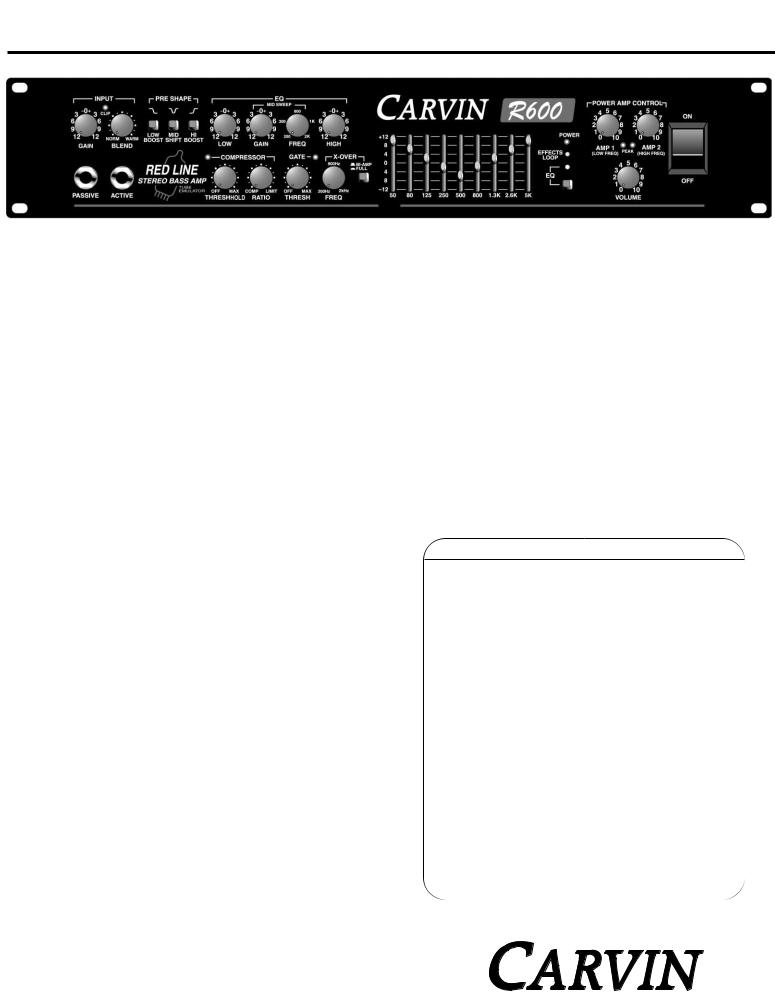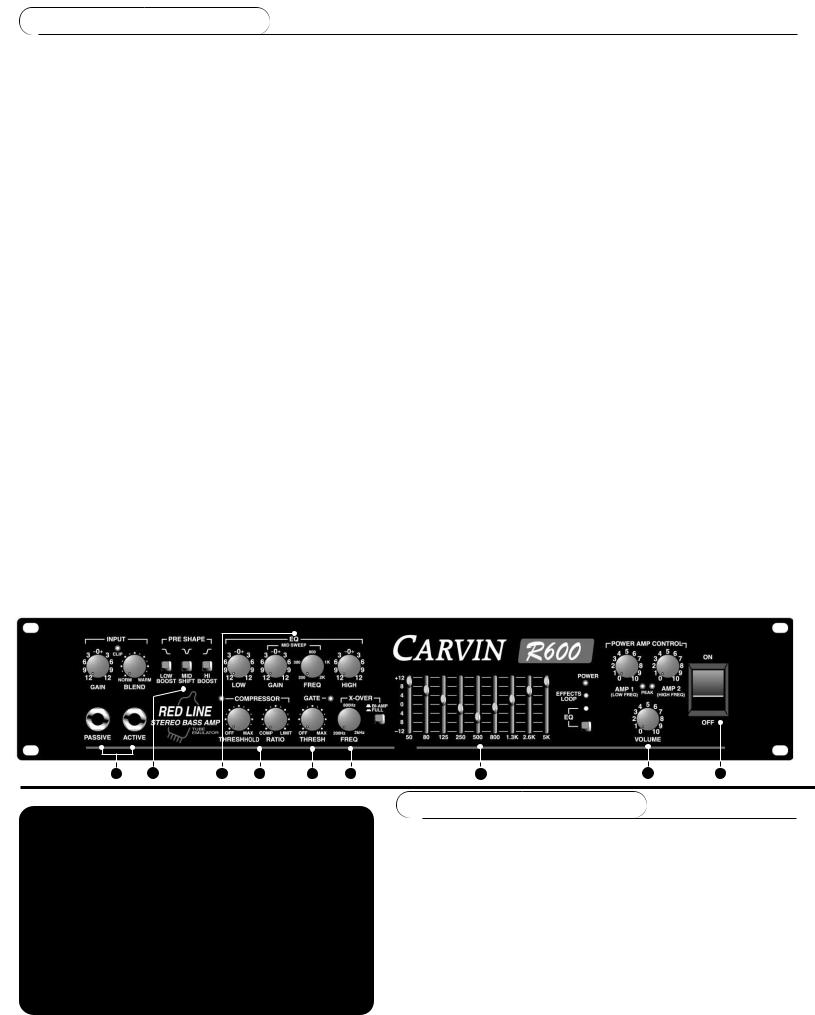Carvin R1000, R600 Owner's Manual

CARVIN ENGINEERING DATA |
SERIES |
|
III |
|
WITH TWIST-LOK SPEAKER CONNECTORS |
R600/R1000 HEAD/RL6815 CYCLOPS/RC210 RED EYE |
|||||
OPERATING MANUAL
Congratulations on your purchase of the Series IIIRedLine bass amp. Your new amp has been totally redesigned from earlier Series I and II releases. Enhancements come from the new internal construction using SMT (surface mounted components). Design changes include the new 12AX7 Tube Emulator (no tube maintenance), noise gate, compressor, high current TwistLok speaker connectors, adjustable Direct Out and separate preamp insert jacks. While all the internal circuits have been changed, the classic outer panel remains the same as one of the leading designs in pro bass amplification. This manual covers the R600 and R1000 head, Cyclops and Red Eye combo amplifiers.
GETTING STARTED QUICKLY
If you are like most players, you probably want to plug in your new amp and get started playing right away. However, with a full featured amp like the R600/R1000, the setup must be right or you will experience unsatisfactory results. Before you start, be sure your amp is plugged into the correct AC voltage.
1.Plug your bass guitar into the ACTIVE (bass with preamp) or PASSIVE (bass with no battery) input jack. With your bass full on and playing hard, be sure the CLIP led next to the input jacks is not flashing (very dim flashing is OK) or preamp distortion will result. Use the ACTIVE input if your instrument continues to cause clipping.
2.The INPUT GAIN control should be set at the center “0” position. The AMP 1 & 2 and MASTER VOLUME levels should be set at their center “5” position. If these setting are too loud, then bring down the MASTER VOLUME. However, the GAIN control should be kept at “0” or higher for the best signal to noise performance. Note, the GAIN control does not turn the input off.
3.Set the COMPRESSOR & GATE to their off position. Read about their functions later.
4.Set the LOW, MID SWEEP and HIGH tone controls to their off center “0” position. Adjust later after you are more familiar with the amp.
5.Set the 9 EQ bands to their “0” center positions and adjust later if needed. The EQ switch is used to defeat the EQ.
6.Set the guitar’s level full on and turn the master VOLUME OFF. Now, turn the amp ON and gradually raise the master VOLUME (set the input GAIN at “0” & the AMP 1 & 2 at “5”). Re-adjust according to the desired volume. Never try to get full power by pushing the input GAIN control to its maximum while keeping the AMP 1 & 2 and MASTER VOLUME levels below 5.
7.Your tone shaping should start with the PRE-SHAPE filters. You can use the tone controls and the 9-band graphic EQ as more tone variation is required. It is not recommended to add a lot of bass if the pre-shape bass filter is used especially at high levels because early clipping can occur. Use moderation when dialing in tone.
8.Use the built-in COMPRESSOR to limit peaks. This will help you get more power from your system by keeping the amps from clipping.
9.Biamping the CYCLOPS combo or any large bass stacks requires careful balancing of the AMP 1 & 2 controls. These amp controls power the woofer and midrange/tweeter independently. Double check to see that the speaker’s components are plugged into the correct amp jacks. If the cables are reversed (feeding the wrong speakers), the BRIDGE switch is inadvertently pushed in, or the front BIAMP switch or X-OVER frequency is incorrectly set, your amp will not perform correctly. Carefully checking these items will help prevent service calls.
10.Need more power? Even though the R600/R1000 is a powerful amp, adding more speakers is the only way for substantially more output. Every time you double your speakers, your acoustic output goes up by a factor of four. This is far more efficient than trying to add 4 times the power especially when speakers become less efficient when driving them harder. Bridging your amp into a 4 ohm system will give you more output. However, speakers can be be damaged from high power or the amp will go into “protect” if loaded below 4 ohms.
Hopefully, this will help you get started. Have fun exploring the many new features and sounds of the R600/R1000. Take your time because you’re new amp has a lot of potential if properly setup!
76-4000 0801
RECEIVING INSPECTION
INSPECT YOUR UNIT FOR ANY DAMAGE which may have occurred during shipping. If any damage is found, please notify the shipping company and CARVIN immediately.
SAVE THE CARTON & ALL PACKING MATERIALS. In the event you have to reship your unit, always use the original carton and packing material. This will provide the best possible protection during shipment. CARVIN and the shipping company are not liable for any damage caused by improper packing.
SAVE YOUR INVOICE. It will be required for warranty service if needed in the future. SHIPMENT SHORTAGE. If you find items missing, they may have been shipped separately. Please allow several days for the rest of your order to arrive before inquiring.
RECORD THE SERIAL NUMBER on the enclosed warranty card or below on this manual for your records. Keep your portion of the card and return the portion with your name and comments to us. You may register your warranty online @carvin.com/registration
DESIGNED FOR TOURING
Every R600 & R1000 is made from heavy-duty 16 gauge steel that is galvanized before being painted to prevent rust. All internal cabling is neatly tied and harnessed. Every circuit card is MIL SPEC, double-sided, through-hole plated, fire retardant FR-4 glass epoxy. This insures that the solder flows on the top, bottom and through each hole of every component, preventing components from shaking loose. Toroid transformers are used as they are the engineer’s choice for greater power supply current while reducing weight and magnetic “hum” fields.
R600/R1000 RED LINE SPECIFICATIONS:
Output Power |
|
|
R600 |
R1000 |
8Ω |
THD < 1% |
175/175w |
225/225w |
|
4Ω |
THD < 1% |
250/250w |
350/350w |
|
2Ω |
THD < 1% |
300/300w |
500/500w |
|
8Ω Bridged |
THD < 1% |
500w |
700w |
|
4Ω Bridged |
THD < 1% |
600w |
1000w |
|
Input Impedance (passive input) |
1MΩ |
|
||
|
(active input) |
200kΩ |
|
|
Pre-Shape EQ. |
|
Low Boost: +8dB @ 80Hz |
||
|
|
Mid Shift: 250 Hz or 500 Hz @ 10dB |
||
|
|
Hi Boost: +6dB @ 3kHz |
||
Main EQ. |
|
Low ±12dB @ 100Hz |
|
|
|
|
Mid Sweep ±12dB @ 200Hz-2kHz |
||
|
|
High ±12dB @ 6kHz |
|
|
Graphic EQ Freq. |
±12dB @ 50, 80, 125, 250, 500, 800, 1.3k, 2.6k, 5k |
|||
|
|
|
||
Compressor |
|
Variable Threshold Range (-10dB to -35dB) |
||
|
|
Variable Ratio Range (1.3 to 1) to (5 to 1) |
||
|
|
|
||
Noise Gate |
|
Variable Threshold Range off to -30dB |
||
|
|
|
||
Crossover |
|
12dB per Octave Sweepable 200Hz to 2kHz |
||
AC Requirements |
|
120VAC 60 Hz or 240VAC 50 Hz optional model |
||
Power Requirements |
R600: 700VA, R1000: 1200VA |
|||
|
|
|
|
|
Dimensions (no cabinet) |
3 1/2” High |
x 19” Wide x |
10” Deep |
|
Shipping Weight with SV2 Duratuff II™ cabinet |
R600: 30 lbs. |
R1000:36 lbs |
||
Warranty |
|
One year parts and labor |
||
For your records, record the following information.
Serial No._____________________ Invoice Date_______________
12340 World Trade Drive, San Diego, CA 92128 858.487.1600 800.854.2235 www.carvin.com

FRONT PANEL CONTROLS
and active instruments. high impedance pickups. input jack. The ACTIVE input
INPUT GAIN knob is used is mixed through the “
close to clipping. To avoid jack.
. The LOW BOOST switch some depth to the bottomoffers two different
250Hz. Depressing this
a 6dB boost at 3kHz. This 18” speakers with no
a sweep midrange control shaping of the low
the response of the bass the mid frequency range.
narrow band of
set to “0”, the mid sweep GAIN knob clockwise is used to select the
way to become familiar with cut or full boost and rotate and experiment with
usually requires some to cut or boost the high
for bringing up the very or popping. Note: using tweeters. This is
to limit the peaks so the speakers without the with THRESHOLD and
. The user can dial up the the compression to begin. kicks in. In the OFF
in the clockwise indicator LED shows
is on. The RATIO knob is reached. When this knob
mild compression. As the The range of available
5 to 1 in the full clockwise
and the volume knobs on the bass will reduce the amount of comTo get a tight limiting sound which is
the full clockwise position and bring realized.
. To use the GATE, mute the strings until the amp’s noise is turned off and as the bass is played. The INPUT
configuration. When the BI-AMP the amp is in the bi-amp mode. To knob until the desired frequency is greater control over the tone of their frequencies to be utilized to their fullest
THE MOST VOLUME FROM YOUR SYSTEM.
center frequencies most requested by the tonal content of the amps output.
FS22 footswitch or the EQ switch sound from the amp. Musicians that get the sounds they desire out of each be useful during passages of a song LED indicator located along the side YELLOW effect loop LED labeled EFF the EQ switch on the front panel off, it cannot be turned on with the
interfaces with other gear and speakto the individual amps. These are range or bi-amping modes (stereo). To the desired volume level is reached. desired balance has been achieved. The
the amplifier on. If the power indicathe amp may have gone into one of off for one minute and then turn the speaker impedance is too low for the min. per amp) b) bad speaker cable,
5 |
6 |
9 |
and AMP 2 (tweet-
or the X-OVER
inadvertently pushed in
damaged from to
each other. To correct,
. If the hum is not elimon the connectors (Pin 3).
SPEAKER CONNECTIONS
Twist-Lok cables are recommended for your bass rig because of their high current capacity. While the standard 16 GA 1/4” cables will work OK with your system, the CARVIN 12 GA Twist-Lok cables will allow you to gain as much as 20% more power at high power levels extracting every watt from your RedLine bass amp. The very short 1/4” cables will work for the RC210 and RL6815 combo amps.
FULL RANGE MODE:
The FULL RANGE mode of your RedLine bass amp works well with separate bass and full-range speaker systems. Instead of using the Bi-Amp mode, you can simply run AMP 1 into your bass speakers and AMP 2 into your full-range speakers using the natural crossover frequencies of each speaker system. If you need deeper bass or more highs, just turn up amp 1 or amp 2 for a balance sound. The front panel X-OVER switch must be pushed “IN” for the FULL-RANGE MODE.
